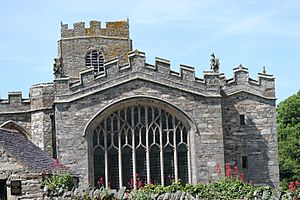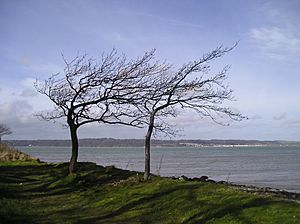George Twisleton facts for kids
Quick facts for kids
George Twisleton
|
|
|---|---|

St Beuno's Church, Clynnog Fawr, where Twisleton was buried in 1667
|
|
| Member of Parliament for Anglesey |
|
| In office September 1654 – April 1659 |
|
| Governor of Denbigh Castle | |
| In office October 1646 – May 1660 |
|
| Personal details | |
| Born | 1618 Drax, West Riding of Yorkshire |
| Died | 12 May 1667 Lleuar Fawr, Carnarvonshire |
| Resting place | St Beuno's Church, Clynnog Fawr |
| Nationality | English |
| Spouse | Mary Glynne c. 1650 to his death |
| Children | George (1652–1714); Margaret; Jane; Philip (died 1701); William (died 1719); Mary (died 1720?); Alice (died 1720?); Elin (died 1727) |
| Military service | |
| Rank | Colonel |
| Battles/wars | |
George Twisleton (1618 – 12 May 1667) was an important figure during a time of great change in England. He was a colonel in the Parliamentarian army, also known as the Roundheads. These were the forces that fought against King Charles I during the Wars of the Three Kingdoms. Later, when England was a republic called the Commonwealth of England, George Twisleton served as a MP for Anglesey from 1654 to 1659.
He was chosen to be part of a special court for the Trial of Charles I in 1649. However, he did not take part in the trial. This decision helped him avoid trouble when the king's son, Charles II, returned to power in 1660. After that, George Twisleton lived a quiet life at his home in Lleuar Fawr, Carnarvonshire, where he passed away in 1667.
Contents
George Twisleton's Early Life and Family
George Twisleton was born in 1618. He was the third son of John Twisleton, who owned land near Drax in Yorkshire. His mother was Margaret Constable, who died in 1626. George had two older brothers, John (1614–1682) and Philip (around 1616–1673). Both of his brothers also supported the Parliament during the wars.
Before 1652, George Twisleton married Mary Glynne (who died in 1676). She was a wealthy woman from Wales. They had many children together. Their children included George (1652–1714), Margaret, Jane, Philip (died 1701), William (died 1719), Mary (died 1720?), Alice (died 1720?), and Elin (died 1727).
Fighting in the First English Civil War
The First English Civil War started in 1642. This was a big conflict between the King and Parliament. George's brother Philip joined the Parliamentarian army in Lincolnshire. George Twisleton's exact role at the very beginning is not fully clear. However, he likely served with the Parliamentarian cavalry.
By April 1645, he was a Lieutenant Colonel. He led a cavalry unit under Sir William Brereton, a Parliamentarian leader in the North Midlands. It is thought that Twisleton's unit might have stayed in the area to help with the Siege of Chester. Chester was a very important city. It connected the King's supporters in Wales and Ireland with his armies in England. By the summer of 1645, Parliament's forces had almost completely surrounded Chester.
Twisleton was based in Oswestry. He worked with Colonel John Carter to push the Royalists out of Montgomeryshire. A major battle called the Battle of Naseby in June 1645 helped Parliament win the war. Soon after, Montgomery Castle surrendered. This gave Parliament control of the area.
This allowed Parliamentarian forces to move north into Denbighshire and Carnarvonshire. In November 1645, they won the Battle of Denbigh Green. This stopped the Royalists from trying to help Chester. Twisleton then led an attack on Whitchurch, Shropshire in December. After that, he was sent to surround Hawarden Castle. Chester finally surrendered in February 1646. Denbigh Castle held out longer, but King Charles I ordered its surrender in October 1646. George Twisleton became the new Governor of Denbigh Castle. He held this important job until 1660.
The Second English Civil War and Later Life
After Parliament won the first war, there were disagreements. The army and many MPs argued about how to run the country. George Twisleton's brother Philip supported the army. In 1647, Philip became the colonel guarding King Charles I.
The Second English Civil War started in April 1648. John Owen, a Royalist, gathered a small army in Carnarvonshire. On June 3, he tried to capture Caernarfon Castle. Twisleton marched to help defend the castle. Two days later, Owen's forces met Twisleton's near Y Dalar Hir. This was close to the Menai Straits. The Royalists seemed to be winning at first. But then Owen was captured, and his forces ran away. This victory, along with another one in May, ended most Royalist fighting in Wales. However, Anglesey was not fully controlled by Parliament until October.
In January 1649, George Twisleton was named as one of the 135 people chosen for the special court to try King Charles I. However, he did not go to the trial. Instead, he focused on his role at Denbigh. He married Mary Glynne. Her father was a very important judge from 1655 to 1660. Her brother, William, became an MP for Caernarfon in 1659.
George Twisleton himself was elected as an MP for Anglesey in 1654. He was re-elected in 1656 and 1659. He served on several committees in Parliament.
In 1660, King Charles II returned to power. This event is called the Stuart Restoration. George Twisleton's army unit was disbanded. He gave up all his official jobs. He then moved to his wife's family estate at Lleuar Fawr. He died there on May 12, 1667. He was buried in St Beuno's Church, Clynnog Fawr.
Sources
| Parliament of England (to 1707) | ||
|---|---|---|
| Preceded by Not represented in Barebones Parliament |
Member of Parliament for Anglesey 1654–1659 |
Succeeded by Not represented in Restored Rump |


